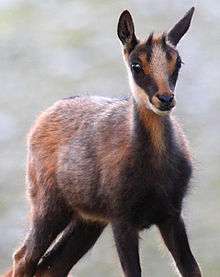Pyrenean chamois
| Pyrenean chamois | |
|---|---|
 | |
| Scientific classification | |
| Kingdom: | Animalia |
| Phylum: | Chordata |
| Class: | Mammalia |
| Order: | Artiodactyla |
| Family: | Bovidae |
| Subfamily: | Caprinae |
| Genus: | Rupicapra |
| Species: | R. pyrenaica |
| Binomial name | |
| Rupicapra pyrenaica (Bonaparte, 1845) | |
The Pyrenean chamois (French: izard or isard, Spanish: rebeco or gamuza, Catalan: isard, Italian: camoscio, Aragonese: sarrio or chizardo), Rupicapra pyrenaica, is a goat antelope that lives in the Pyrenees, Cantabrian Mountains and Apennine Mountains. It is one of the two species of the genus Rupicapra, the other being the Chamois, Rupicapra rupicapra. It is in the Caprinae subfamily of bovids, along with sheep and goats.
Up to 80 cm tall, its summer coat is a ruddy brown; in winter it is black/brown with darker patches around the eyes. Both males and females have backward-hooked horns up to 20 cm in length. They browse on grass, lichens and buds of trees. Sure-footed and agile, they are found anywhere up to 3000 m.
Like other species of chamois, it was hunted almost to extinction, especially in the 1940s, for the production of chamois leather. The population has since recovered and in 2002 was estimated to be about 25,000. (Pérez et al., 2002)

Subspecies
- R. pa. pyrenaica (Pyrenean chamois)
- R. p. parva (Cantabrian chamois): Spain
- R. p. ornata (Apennine chamois): Central and south Italy
References
- ↑ Herrero, J.; Lovari, S. & Berducou, C. (2008). "Rupicapra pyrenaica". IUCN Red List of Threatened Species. Version 2008. International Union for Conservation of Nature. Retrieved 5 April 2009. Database entry includes a brief justification of why this species is of least concern.
- Haack, M. 2002. Rupicapra pyrenaica. Animal Diversity Web. Accessed February 20, 2006.
- Pérez, T., Albornoz, J. & Domínguez, A. (2002). Phylogeography of chamois (Rupicapra spp.) inferred from microsatellites. Mol Phylogenet Evol. 25, 524–534.
- Pérez-Barbería, F. J., García-González, R. (2004). "Rebeco – Rupicapra pyrenaica." Enciclopedia Virtual de los Vertebrados Españoles. Carrascal, L. M., Salvador, A. (Eds.). Museo Nacional de Ciencias Naturales. Madrid, Spain.
